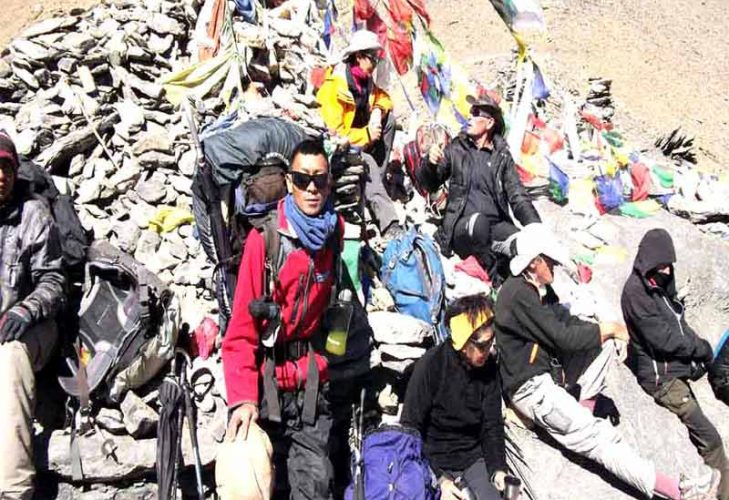Detail Itinerary for the Upper Dolpo Circuit trek

Detail Itinerary for the Upper Dolpo Circuit trek
The Upper Dolpo trek is located in the remote and rugged region of Dolpo in Nepal, and it is known for its stunning landscapes, unique culture, and high-altitude challenges passage. The altitude values provided are approximate and may vary slightly depending on the source and specific routes taken during the trek.
Duration: Approximately 25 to 28 days (including Kathmandu to Kathmandu)
Altitude Range: The trek generally ranges between 2,850 meters (9,350 feet) to 5,360 meters (17,580 feet) above sea level.
Day 1: Arrival in Kathmandu (1300 Meters)
Arrive at Tribhuvan International Airport in Kathmandu. Transfer to your hotel and spend the rest of the day. Overnight stay in Kathmandu.
Day 2: Kathmandu – Rest day, trek preparation, and obtaining necessary permits.
Day 3: Kathmandu to Nepalgunj (150 meters/490 feet) one-hour flight.
Day 4: Nepalgunj to Jhupal (Dolpo) and trek to Dunai (2,850 meters/9,350 feet) 25 minutes flight and 2-3 hours walking.
Day 5: Dunai to Chhepka (2,838 meters/9,311 feet). 5-6 hours.
Day 6: Chhepka to Chunuwar/Jharana Hotel (3,130 meters/10,266 feet). 5-6 hours.
Day 7: Chunuwar to Phoksundo Lake (3,611 meters/11,847 feet). 5-6 hours.
Day 8: Acclimatization day at Phoksundo Lake – Rest day and exploration
Day 9: Phoksundo Lake to Phoksundo Khola (3,507 meters/11,507 feet). 5-6 hours.
Day 10: Phoksundo Khola to Phoksundo Bhanjyang (4,402 meters/14,465 feet). 5-6 hours.
Day 11: Phoksundo Bhanjyang to Shey Gompa (4,500 meters/14,763 feet) via Kang-La Pass (5,360 meters/17,580 feet). 6-7 hours.
Day 12: Shey Gompa to Namduna Gaon (4,800 meters/15,748 feet) via Saldang La Pass (5,200 meters/17,056 feet) 5-6 hours.
Day 13: Namduna Gaon to Saldang (3,903 meters/12,805 feet). 4-5 hours.
Day 14: Saldang to Yangze Gompa (4,960 meters/16,273 feet). 5-6 hours.
Day 15: Yangze Gompa to Sibu (4,560 meters/14,961 feet) via Jeng La Pass (5,090 meters/16,696 feet) 6-7 hours.
Day 16: Sibu to Lang Khola Camp (4,550 meters/14,928 feet). 5-6 hours.
Day 17: Lang Khola Camp to Tokyu Gaon (4,200 meters/13,780 feet) via Mola La Pass (5,000 meters/16,404 feet). 5-6 hours.
Day 18: Tokyu Gaon to Dho Tarap (4,090 meters/13,415 feet).5-6 hours.
Day 19: Rest day in Dho Tarap – Acclimatization and exploration
Day 20: Dho Tarap to Tarap Khola (3,800 meters/12,467 feet).5-6 hours.
Day 21: Tarap Khola to Khanigaon (3,150 meters/10,332 feet).5-6 hours.
Day 22: Khanigaon to Tarakot (2,537 meters/8,323 feet).5-6 hours.
Day 23: Tarakot to Dunai (2,850 meters/9,350 feet). 5-6 hours.
Day 24: Dunai to Jhupal). 2-3 hours.
Day 25: Jhupal to Nepalgunj and then to Kathmandu
Day 27: Kathmandu
Relax and explore the city or do some souvenir shopping hotel include with breakfast.
Day 28: Departure from Kathmandu
Transfer to the airport for your departure. Say goodbye to Nepal with memories of an incredible adventure.
Please keep in mind that the actual itinerary may be subject to changes due to weather conditions, group pace, and other factors. Additionally, the high-altitude nature of this trek requires trekkers to be in good physical condition and properly acclimatized to avoid altitude sickness. It is essential to trek with a reputable agency and experienced guides to ensure safety and support throughout the journey.
The best time to make the Upper Dolpo Circuit Trek is during the trekking seasons in Nepal, which are primarily spring (April to June) and autumn (September to November). Both seasons offer favorable weather conditions, stable temperatures, and clear skies, making them ideal for trekking in the remote and rugged region of Upper Dolpo.
Spring Season (April to June): During spring, the weather starts to warm up after the colder winter months. The rhododendron forests along the trail come alive with colorful blooms, creating a picturesque landscape. The days are usually pleasant, and the skies are clear, providing excellent mountain views. Spring is also a great time for wildlife sightings, as many animals become more active. However, keep in mind that nights at higher elevations can still be quite cold during this season.
Autumn Season (September to November): Autumn is the most popular and busy trekking season in Nepal, including Upper Dolpo. The weather during this time is dry and stable, with moderate temperatures, making it comfortable for trekking. The skies are generally clear, offering stunning views of the surrounding peaks. The landscapes are lush and green after the monsoon season, adding to the beauty of the trek. The autumn months are also the time when many traditional festivals take place in Nepal, providing a cultural experience for trekkers.
Both spring and autumn seasons are suitable for the Upper Dolpo Circuit Trek, and the choice between them depends on your preferences and schedule. If you prefer to see the blooming rhododendrons and experience the post-winter environment, spring might be the better option. On the other hand, if you enjoy the green landscapes and clear mountain views after the monsoon season, then autumn is a great choice.
Avoid trekking during the monsoon season (July to August) as heavy rainfall can make the trails slippery and leech-infested. Winter (December to March) is extremely cold and harsh, with high passes blocked by snow, making it unsuitable for most trekkers.
Before undertaking the Upper Dolpo Circuit Trek, make sure to plan ahead, book with a reputable trekking agency, and be well-prepared with proper gear and clothing for a safe and enjoyable adventure.
